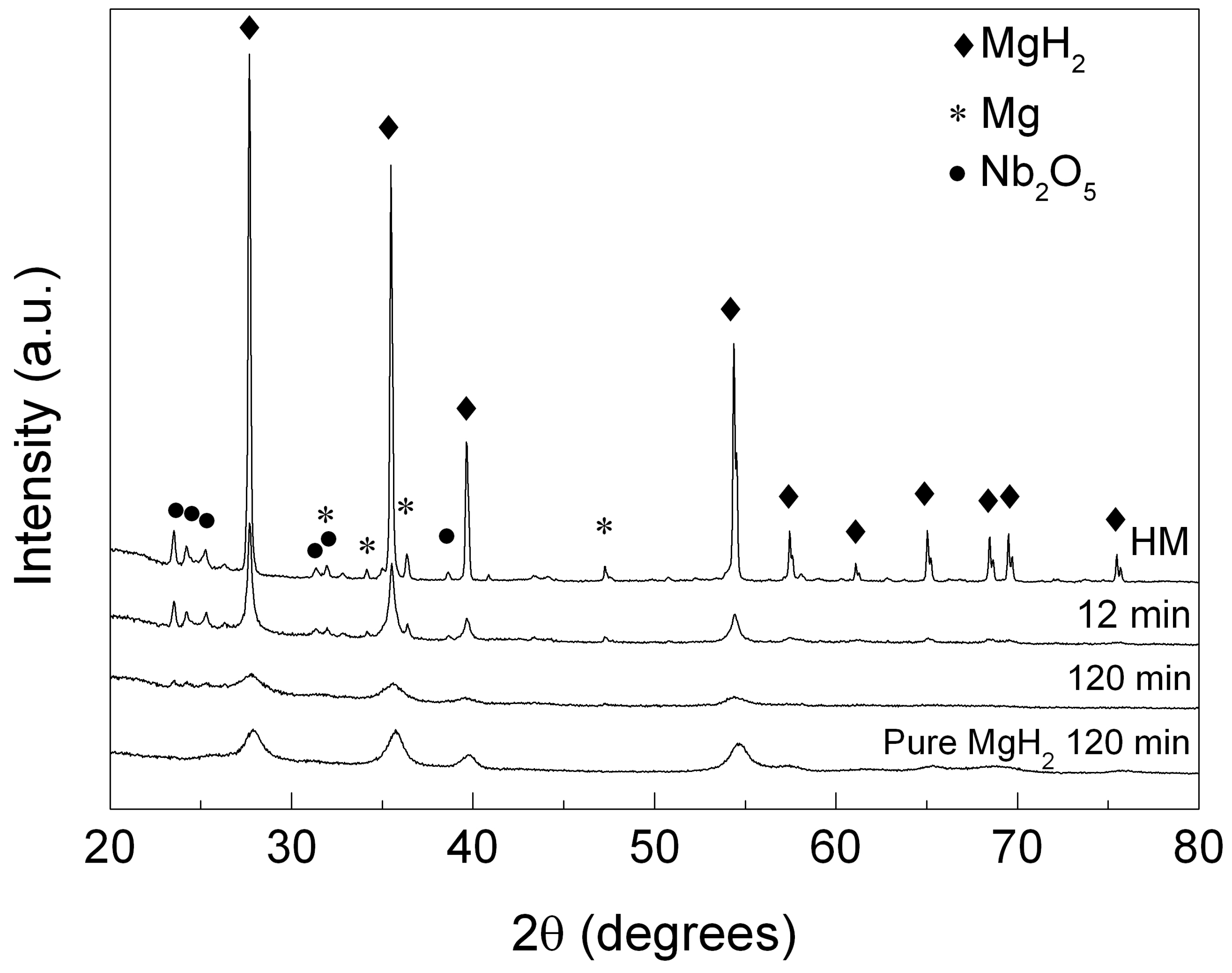Catalytic Effect of Nb2O5 in MgH2-Nb2O5 Ball-Milled Composites
Abstract
:1. Introduction
2. Results and Discussion




| Catalyzed | Pure | ||||||
|---|---|---|---|---|---|---|---|
| Plane | 2 θ(°) | FWHM (°) | τ (Å) | Plane | 2 θ(°) | FWHM (°) | τ (Å) |
| (110) | 28.0 | 1.26 | 73.9 | (110) | 27.9 | 0.813 | 103 |
| (101) | 35.8 | 1.35 | 72.8 | (101) | 35.7 | 0.795 | 104 |
| (211) | 54.6 | 1.32 | 78.5 | (211) | 54.6 | 0.839 | 105 |


3. Experimental Procedures
4. Conclusions
Acknowledgments
References
- Jain, I.; Jain, P.; Jain, A. Novel hydrogen storage materials: A review of lightweight comlex hydrides. J. Alloy. Compd. 2010, 503, 303–339. [Google Scholar] [CrossRef]
- Chen, P.; Xiong, Z.; Luo, J.; Lin, J.; Tan, K.L. Interaction of hydrogen with metal nitrides and imides. Nature 2002, 420, 302–304. [Google Scholar] [CrossRef]
- Chen, P.; Xiong, Z.; Luo, J.; Lin, J.; Tan, K.L. Nteraction between lithium amide and lithium hydride. J. Phys. Chem. B 2003, 107, 10967–10970. [Google Scholar] [CrossRef]
- Hu, M.G.; Geanangel, R.A.; Wendlandt, W.W. The thermal decomposition of ammonia borane. Thermochim. Acta 1978, 23, 249–255. [Google Scholar] [CrossRef]
- Stephens, F.H.; Pons, V.; Baker, R.T. Ammonia-borane: The hydrogen source par excellence? Dalton Trans. 2007. [Google Scholar] [CrossRef]
- Selvam, P.; Viswanathan, B.; Swamy, C.S.; Srinivasan, V. Magnesium & magnesium alloy hydride. Int. J. Hydrogen Energ. 1986, 11, 169–192. [Google Scholar] [CrossRef]
- Jason, G.; James, J.R. Thermodynamics of the α, β and γ polymorphs of AlH3. J. Alloy. Compd. 2006, 424, 262–265. [Google Scholar] [CrossRef]
- Targets for Onboard Hydrogen Storage Systems for Light-Duty Vehicles. Available online: http://www1.eere.energy.gov/hydrogenandfuelcells/storage/pdfs/targets onboard hydro storage explanation.pdf (accessed on 3 September 2012).
- Barkhordarian, G.; Klassen, T.; Bormann, R. Fast hydrogen sorption kinetics of nanocrystalline Mg using Nb2O5 as catalyst. Scripta Mater. 2003, 49, 213–217. [Google Scholar] [CrossRef]
- Jin, S.A.; Shim, J.H.; Cho, Y.W.; Yi, K.W. Dehydrogenation and hydrogenation characteristics of MgH2 with transition metal fluorides. J. Power Sources 2007, 172, 859–862. [Google Scholar] [CrossRef]
- Borgschulte, A.; Bösenberg, U.; Barkhordarian, G.; Dornheim, M.; Bormann, R. Enhanced hydrogen sorption kinetics of magnesium by destabilized MgH2. Catal. Today 2007, 120, 262–269. [Google Scholar] [CrossRef]
- Barkhordarian, G.; Klassen, T.; Bormann, R. Kinetic investigation of the effect of milling time on the hydrogen sorption reaction of magnesium catalyzed with different Nb2O5 contents. J. Alloy. Compd. 2006, 407, 249–255. [Google Scholar] [CrossRef]
- Hanada, N.; Ichikawa, T.; Hino, S.; Fujii, H. Remarkable improvement of hydrogen sorption kinetics in magnesium catalyzed with Nb2O5. J. Alloy. Compd. 2006, 420, 46–49. [Google Scholar] [CrossRef]
- Hanada, N.; Hirotoshi, E.; Ichikawa, T.; Akiba, E.; Fujii, H. SEM and TEM characterization of magnesium hydride catalyzed with Ni nano-particle or Nb2O5. J. Alloy. Compd. 2008, 450, 395–399. [Google Scholar] [CrossRef]
- Porcu, M.; Petford-Long, A.; Sykes, J. TEM studies of Nb2O5 catalyst in ball-milled MgH2 for hydrogen storage. J. Alloy. Compd. 2008, 453, 341–346. [Google Scholar] [CrossRef]
- Hanada, N.; Ichikawa, T.; Isobe, S.; Nakagawa, T.; Tokoyoda, K.; Honma, T.; Fujii, H.; Kojima, Y. X-ray absorption spectroscopic study on valence state and local atomic structure of transition metal oxides doped in MgH2. J. Phys. Chem. C 2009, 113, 13450–13455. [Google Scholar]
- Friedrichs, O.; Sánchez-López, J.; López-Cartes, C.; Dornheim, M.; Klassen, T.; Bormann, R.; Fernández, A. Chemical and microstructural study of the oxygen passivation behaviour of nanocrystalline Mg and MgH2. Appl. Surf. Sci. 2006, 252, 2334–2345. [Google Scholar] [CrossRef]
- Cullity, B.; Stock, S. Elements of X-ray Diffraction, 3rd ed; Prentice-Hall Inc.: Upper Saddle River, NJ, USA, 2001. [Google Scholar]
- Ma, T.; Isobe, S.; Morita, E.; Wang, Y.; Hashimoto, N.; Ohnuki, S.; Kimura, T.; Ichikawa, T.; Kojima, Y. Correlation between kinetics and chemical bonding state of catalyst surface in catalyzed magnesium hydride. Int. J. Hydrog. Energy 2011, 36, 12319–12323. [Google Scholar] [CrossRef]
- Isobe, S.; Ono, A.; Yao, H.; Wang, Y.; Hashimoto, N.; Ohnuki, S. Study on reaction mechanism of dehydrogenation of magnesium hydride by in situ transmission electron microscopy. Appl. Phys. Lett. 2010, 96, 223109. [Google Scholar] [CrossRef]
- Friedrichs, O.; Aguey-Zinsou, F.; Fernánchez, J.R.A.; Sánchez-López, J.; Justo, A.; Klassen, T.; Bormann, R.; Fernández, A. MgH2 with Nb2O5 as additive, for hydrogen storage: Chemical, structural and kinetic behavior with heating. Acta Mater. 2006, 54, 105–110. [Google Scholar] [CrossRef]
- Yao, H.; Isobe, S.; Wang, Y.; Hashimoto, N.; Ohnuki, S. Plastic bag method for active sample loading into transmission electron microscope. J. Electron Microsc. 2011, 60, 375–378. [Google Scholar] [CrossRef]
© 2012 by the authors; licensee MDPI, Basel, Switzerland. This article is an open-access article distributed under the terms and conditions of the Creative Commons Attribution license (http://creativecommons.org/licenses/by/3.0/).
Share and Cite
Ma, T.; Isobe, S.; Wang, Y.; Hashimoto, N.; Ohnuki, S. Catalytic Effect of Nb2O5 in MgH2-Nb2O5 Ball-Milled Composites. Catalysts 2012, 2, 344-351. https://doi.org/10.3390/catal2030344
Ma T, Isobe S, Wang Y, Hashimoto N, Ohnuki S. Catalytic Effect of Nb2O5 in MgH2-Nb2O5 Ball-Milled Composites. Catalysts. 2012; 2(3):344-351. https://doi.org/10.3390/catal2030344
Chicago/Turabian StyleMa, Tao, Shigehito Isobe, Yongming Wang, Naoyuki Hashimoto, and Somei Ohnuki. 2012. "Catalytic Effect of Nb2O5 in MgH2-Nb2O5 Ball-Milled Composites" Catalysts 2, no. 3: 344-351. https://doi.org/10.3390/catal2030344




